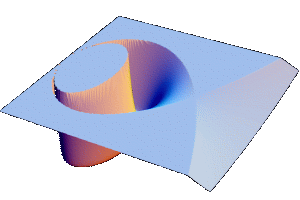| The motion of a charged particle in a magnetic dipole-field is today called the Stoermer problem. Since a long time, physicists and mathematicians have in the context of the northern lights and cosmic radiation been interested how a charged particle moves in the magnetic field of the earth. The problem has turned out to be difficult. After decades of searching for an additional integral besides the energy and the angular momentum, one has realized that the problem is not integrable. A model problem of Brown which simulates a Poincare return map has indeed been shown to have a horse shoe. |
|
be a rotational symmetric vector potential in cylinder coordinates
This vector potential generates a magnetic field
which is rotational symmetric. The Hamiltonian
system of the Störmer problem describes the motion of a single
charged particle of charge q, mass m and velocity v
in the magnetic dipole field B.
This is a sketch. For more details see
Alex Dragt, Trapped orbits in
a magnetic dipole field; Rev. of Geophys.3(2) (1965), pp.255-298
and More literature.
[Added August 6, 2012: Thanks to Sateesh R. Mane for some corrections on this page].
Let
This vector potential generates a magnetic field
The relativistic Hamilton function of the particle is in
cylinder coordinates given by
where c is the speed of light,
Because v2 and so The equivalence of the two Hamilton function K and H can be seen by observing that the partial derivatives with respect to all dynamical variables agree. Because H is invariant under the one-parameter group of rotations along the z axes, there is by Noether's theorem an integral After elimination of the variable
After introducing dimensionless variables
The potential V vanishes on the 'Thalweg'
The Störmer problem is to analyze the two degree of freedom
Hamiltonian system with Hamiltonian
 The energy surface H(q,p)=E with 0<E<1/32 contains a compact
component on which the flow is area preserving. The two dimensional
hyper-surface q1=0 in the energy surface is a Poincaré surface
and the ruturn map is a symplectic map. The second iterate of this
return map can be written as a composition of integrable twist maps.
The first map is to shoot the particle from q2=0 to the north
(with p2>0) and wait until it comes
back. The second map is to shoot the particle from q2=0 to the south
and wait until it comes back to the equator q2=0.
Both maps are twist maps in the plane which have a single fixed point
which is the initial condition which shoots the particle into the dipole.
That this map is integrable has been shown by finding a regularization of
the motion near the singularity of the dipole.
The two fixed points of the two maps do not agree, the two maps don't
commute. When shooting to the north pole, the particle will not bounce
back to the south pole.
The situation is similar to take a two horn-like surfaces of
revolution and glue them together a bit tilted, leading to a two
dimensional surface of revolution with one line, where the metric is
discontinuous. Writing this in Texas, it is a Longhorn, the left
horn representing the charged particle on the north hemisphere, the
right horn representing the charged particle on the south hemisphere.
The geodesic flow on this surface of revolution is a
Hamiltonian system which is very similar to the Hamiltonian system of the
Störmer problem.
The energy surface H(q,p)=E with 0<E<1/32 contains a compact
component on which the flow is area preserving. The two dimensional
hyper-surface q1=0 in the energy surface is a Poincaré surface
and the ruturn map is a symplectic map. The second iterate of this
return map can be written as a composition of integrable twist maps.
The first map is to shoot the particle from q2=0 to the north
(with p2>0) and wait until it comes
back. The second map is to shoot the particle from q2=0 to the south
and wait until it comes back to the equator q2=0.
Both maps are twist maps in the plane which have a single fixed point
which is the initial condition which shoots the particle into the dipole.
That this map is integrable has been shown by finding a regularization of
the motion near the singularity of the dipole.
The two fixed points of the two maps do not agree, the two maps don't
commute. When shooting to the north pole, the particle will not bounce
back to the south pole.
The situation is similar to take a two horn-like surfaces of
revolution and glue them together a bit tilted, leading to a two
dimensional surface of revolution with one line, where the metric is
discontinuous. Writing this in Texas, it is a Longhorn, the left
horn representing the charged particle on the north hemisphere, the
right horn representing the charged particle on the south hemisphere.
The geodesic flow on this surface of revolution is a
Hamiltonian system which is very similar to the Hamiltonian system of the
Störmer problem. The Katok-Strelcyn conditions required for Pesin theory are satisfied. An open problem is to establish positive Kolmogorov-Sinai entropy. One would have to show the positivity of the Lyapunov exponent on a set of positive Lebesgue measure. |